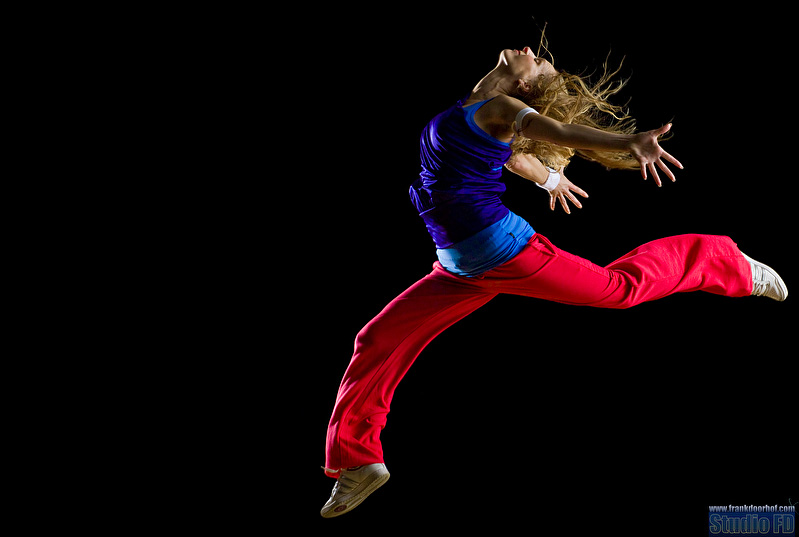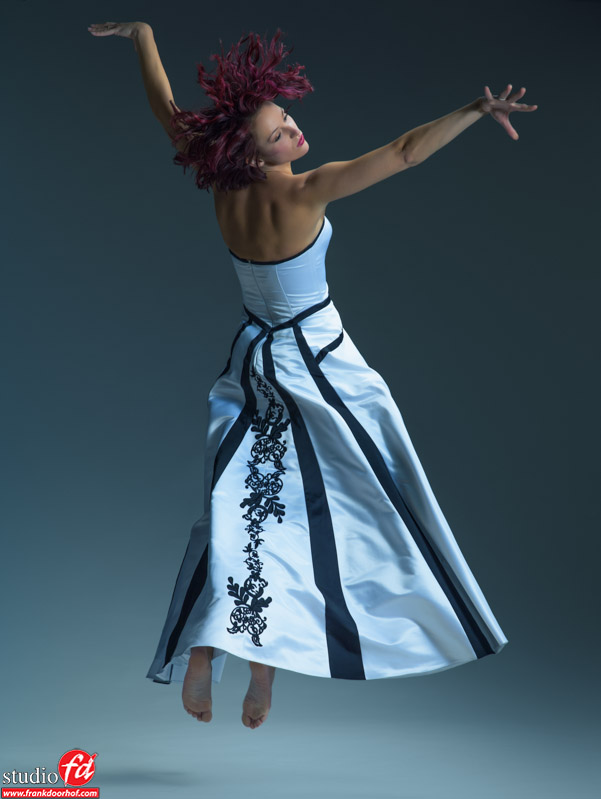The obsession of the shutter speed
This is a question I get A LOT, and I really mean A LOT.
So I thought it was time to type a blog post about it.
If you want to freeze action like this you need a fast shutter speed right?

Well actually not.
In the studio our sync speed is set to 1/125 this is the so called X-sync.
For system strobes this is often 1/200 or 1/250.
Now I hear you wondering “How can you freeze a jump with only 1/125?”
Well the answer is very simple.
Let’s first do a little test so you understand what’s going on.
First set the mainlight on F16 ISO100 with your light meter (or whatever method you use)
Take off the trigger from your hotshoe and take a shot on F16, 1/125, ISO100 (Manual mode of course).
How does the image look?
Black right?
Well we just proved that there is no ambient light registering on your sensor on 1/125.
Now connect the trigger again and take the same shot, now you can see your model right?
This little test proves without any doubt that you don’t need 1/250 to shoot in the studio for jump photography.
Now what does freeze the action?
The freezing of the motion is done by the strobe itself. The speed on which this happens is called the Flashduration.
Some manufacturers will put this on their site or in the manual. For a good freezing power I always advise to buy strobes that are able to at least use a flashduration of 1/2000 of a second, but preferable a little bit more.
My strobe has those specs but everything is still “blurry”
Yep that can happen.
Most studio strobes will give you the max freezing power on full power, but to be sure also check on the lowest setting. If you’re shooting with older strobes it’s often the lowest setting that gives you the fastest flashduration or if you’re shooting with the system flashes (small flash) it’s also the lowest setting.
But it can also be the fact that you are timing the jump wrong. As a joke I always say “the perfect jump shooting moment is that moment where the model is thinking “should I go further up, or down” and on mother Earth she will always go down”… what I mean of course is that you have to shoot at the “floating” moment, that point in the jump where the model is actually hanging still in the air, or close too.
One tip I always give people is to prefocus on the spot where the model will be in the air, you can mark this on the floor of course and hold the focus (or use manual focus on a tripod) until the moment the jump takes place. The advantage of shooting F16 is that you actually have a nice area that will be in focus.
My model never fits the paper 🙁
Yep that can happen, however it should not if you have enough room.
This is where I love longer lenses, the lens will actually change your field of view and the model will fit nicely on the paper, a longer lens narrows the field of view while a wider angle will widen this field of view (meaning the model will hit the sides of the paper very quickly), with a 200mm and moving back enough you can photograph a jumping model with her arms wide open.
 Conclusion
Conclusion
Recently there was a discussion on the blog where people were using bounce flash from a camera just to get from 1/160 to 1/250 and with all due respect to the poster (sorry) this is totally unnecessary, in fact you are actually creating a huge problem because by using the flash to bounce and trigger the studio strobes you are in reality adding some strobe lights from that strobe into your image. So why is it of no use?
First of all the difference between let’s say 1/125 and 1/250 is only one stop, if your studio has so much light coming in that this is important I think it’s time to start working on that first. Now if you’re on location 1 stop can make a difference, but you can also choose to go to ISO50 or use a ND filter of course but there it does makes sense (and a lot of sense). In the studio however there is absolutely no difference that you can see between shooting an image on 1/100 1/125 or 1/400 and if there is, it’s probably a too high level of ambient light and that should be addressed first in my opinion a studio should be able to be dark to judge your light setup.
If you want to determine if your mind is playing tricks on you because you think that something on 1/125 is less sharp than on 1/250 do the same trick as I explained at the beginning, take away your trigger and shoot the same image, if the frame is black there should be no difference between 1/125 or 1/250
Hope this helps.


A new year and a new fantastic article from Frank. 🙂
thanks, I thought let’s start the year with some “speed”
I can only agree Frank! Well written. I remember 7 years ago when I did come to the same conclusions about shutter times in studio…and if it’s “less” ambient light you can use an even longer shutter speed…trigger your light several (like 3) times during the jump and get a nice shot.
I know a lot of people who do not get this concept but after showing them the results with slow shutterspeed they are convinced.
I know you did not mention the t.1 and t.5 time, is the 1/2000 seconds you mentioned a t.1 or t.5 duration? (for the curious: t.5 is the moment 50% of the light has been thrown out while t.1 is the moment 90% of the light has been thrown out)
The Paul Buff Einstein has the fastest time at the lowest setting while in action mode (1/13000 t.1 time) contrary to most other brands. The Paul Buff Alien Bees are the fastest on full power.
T.5 values for the Elinchroms.
Also the Elinchroms are fastest on full power.
Never played with the Alien Bees, they are not sold over here.
Einstein and Alien Bees are sold in Europe by a UK company but way more expensive (almost double) then here in the US so that is why you don’t see them a lot in the old country.
A lot and I really mean a LOT of people here in the US use the Alien Bees and recently more and more people use the Einstein from Paul Buff http://www.paulcbuff.com. It is very affordable. I have 2 AB 800 (cost each $280 power: 10 Ws to 320 Ws) and 1 Einstein (cost $500 power: 2.5 Ws to 640 Ws) including the proprietary triggersystem called cybersync and the cybercommander (with a built in lightmeter) to change settings (Model-light, power, group etc) it’s kind of a skyport. As they say here: “The best bang for the buck”
I you want to I can relate to this when appropriate.
I was looking 6-7 years ago and then it was not yet sold here, was very interested at that time but Paul did not want to send them to me because I was in Europe.
Frank, how can i get f16 from my main light, the max im getting is f11 on full power—–using Latolite 400s
Depends on the modifier, distance to the model, ISO etc.
For the first image, what strobe did you use? RX ranger? and was the power set at full power?